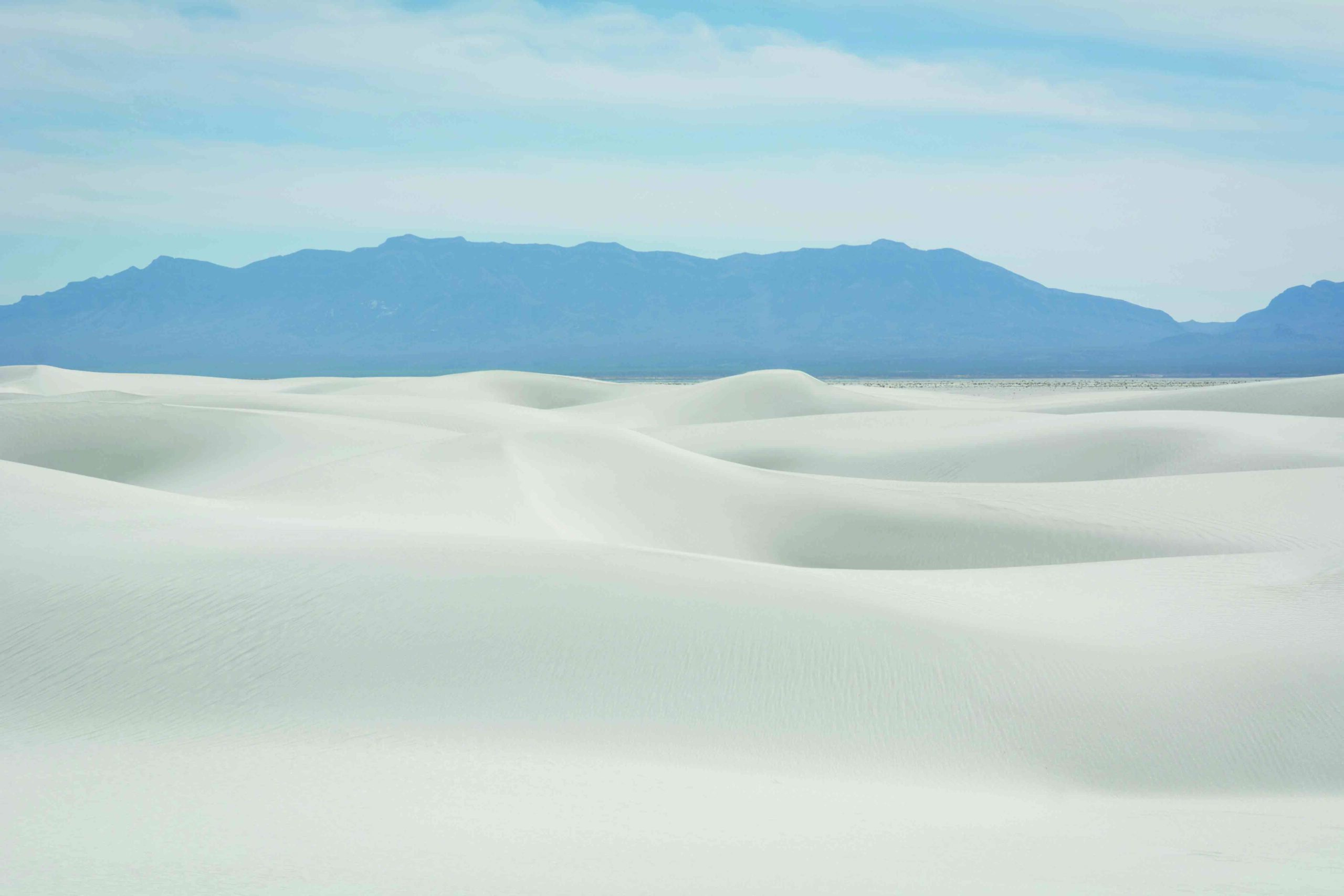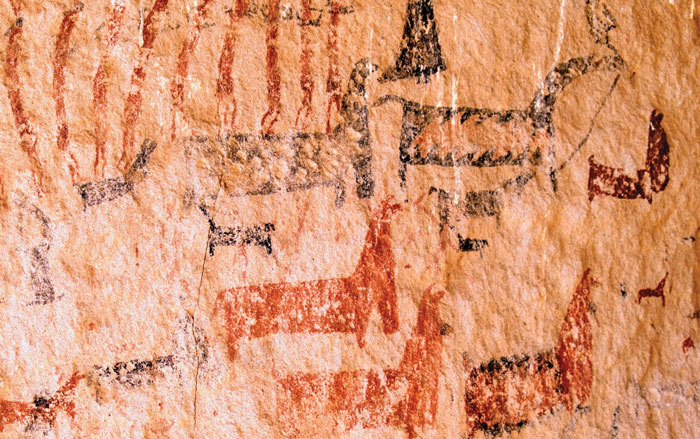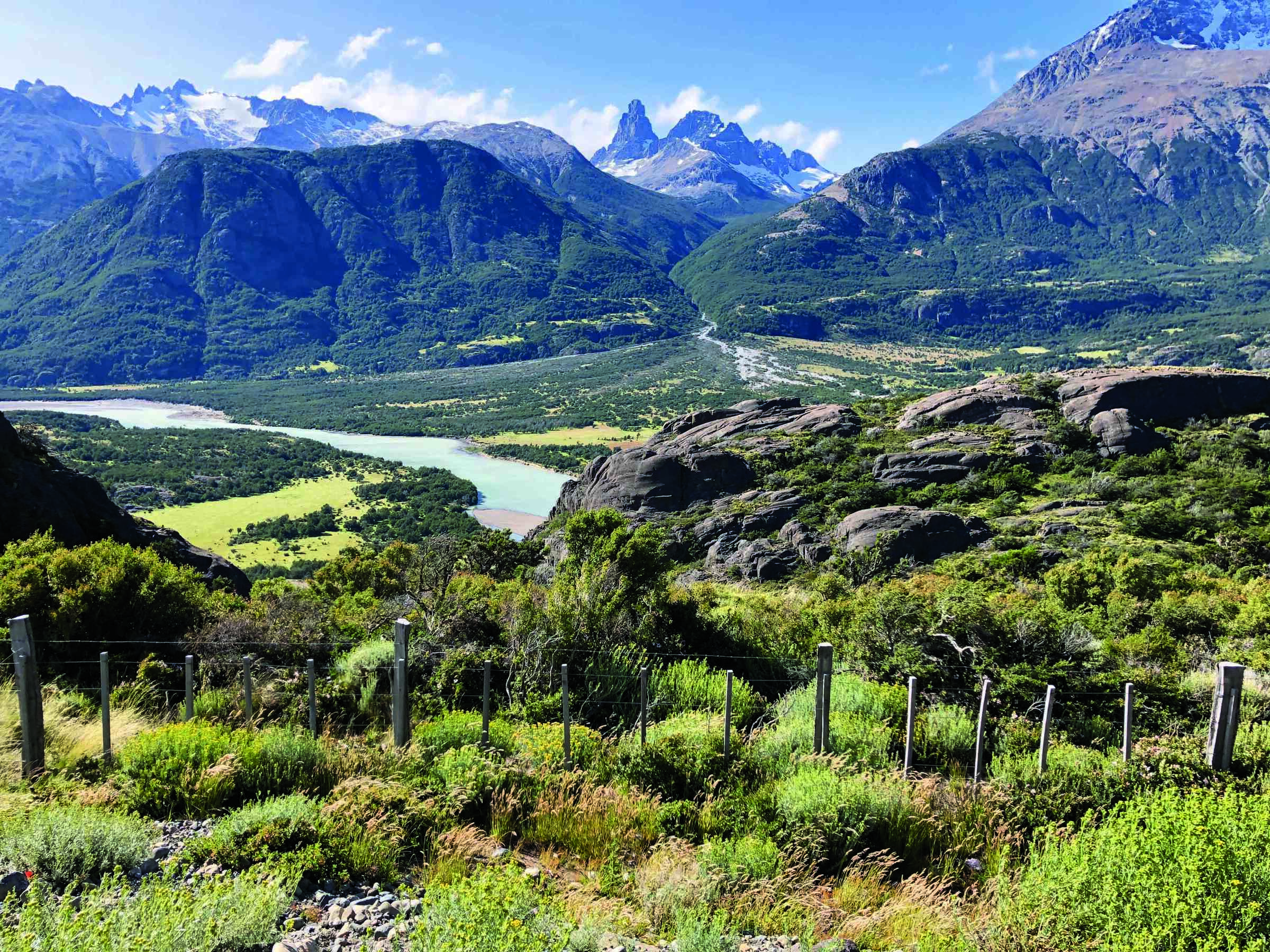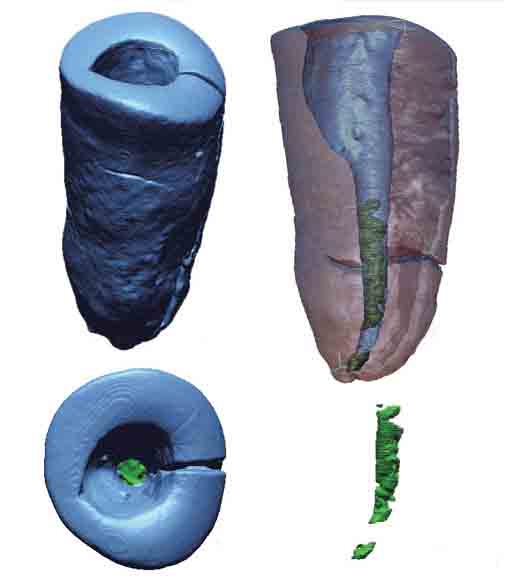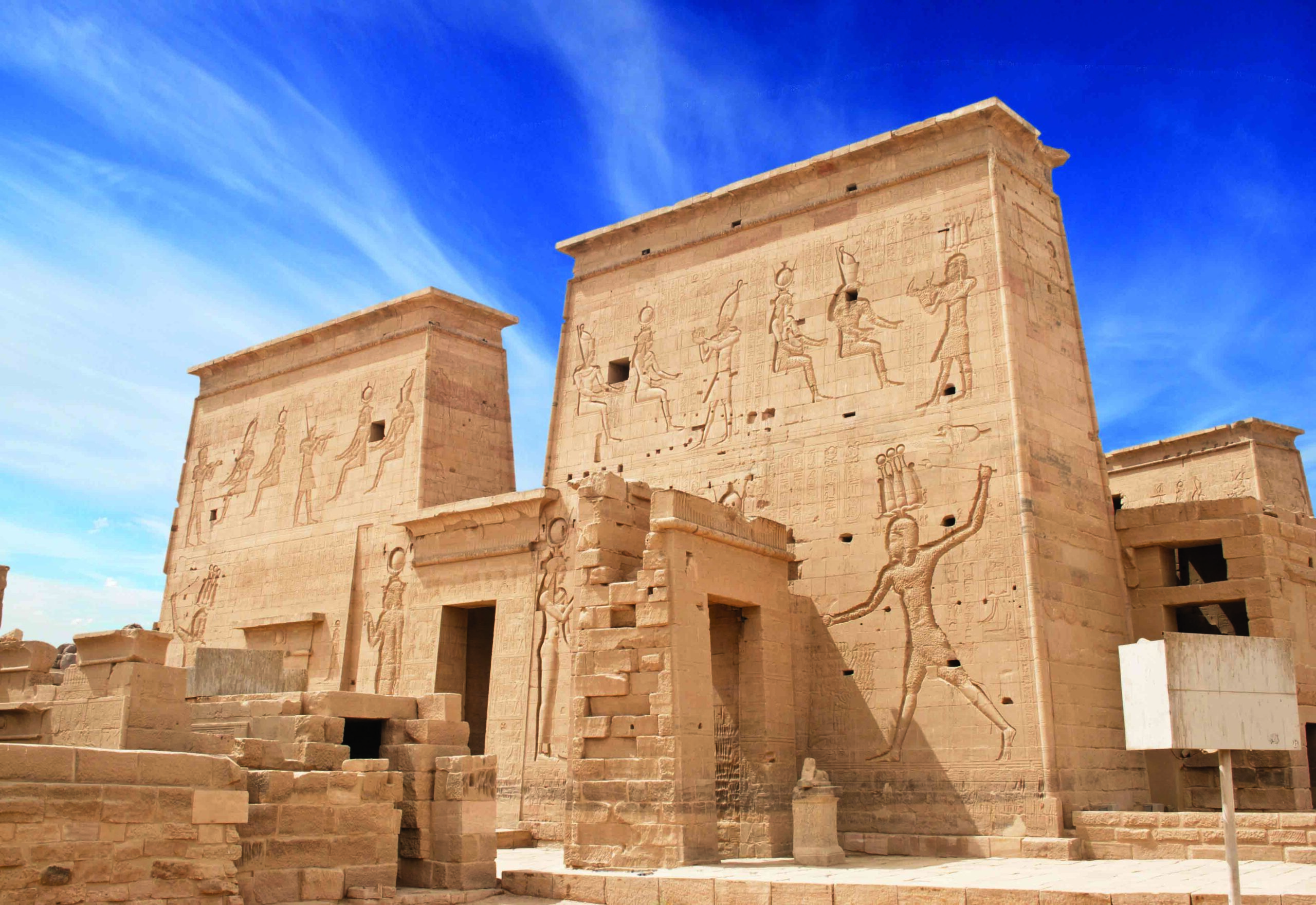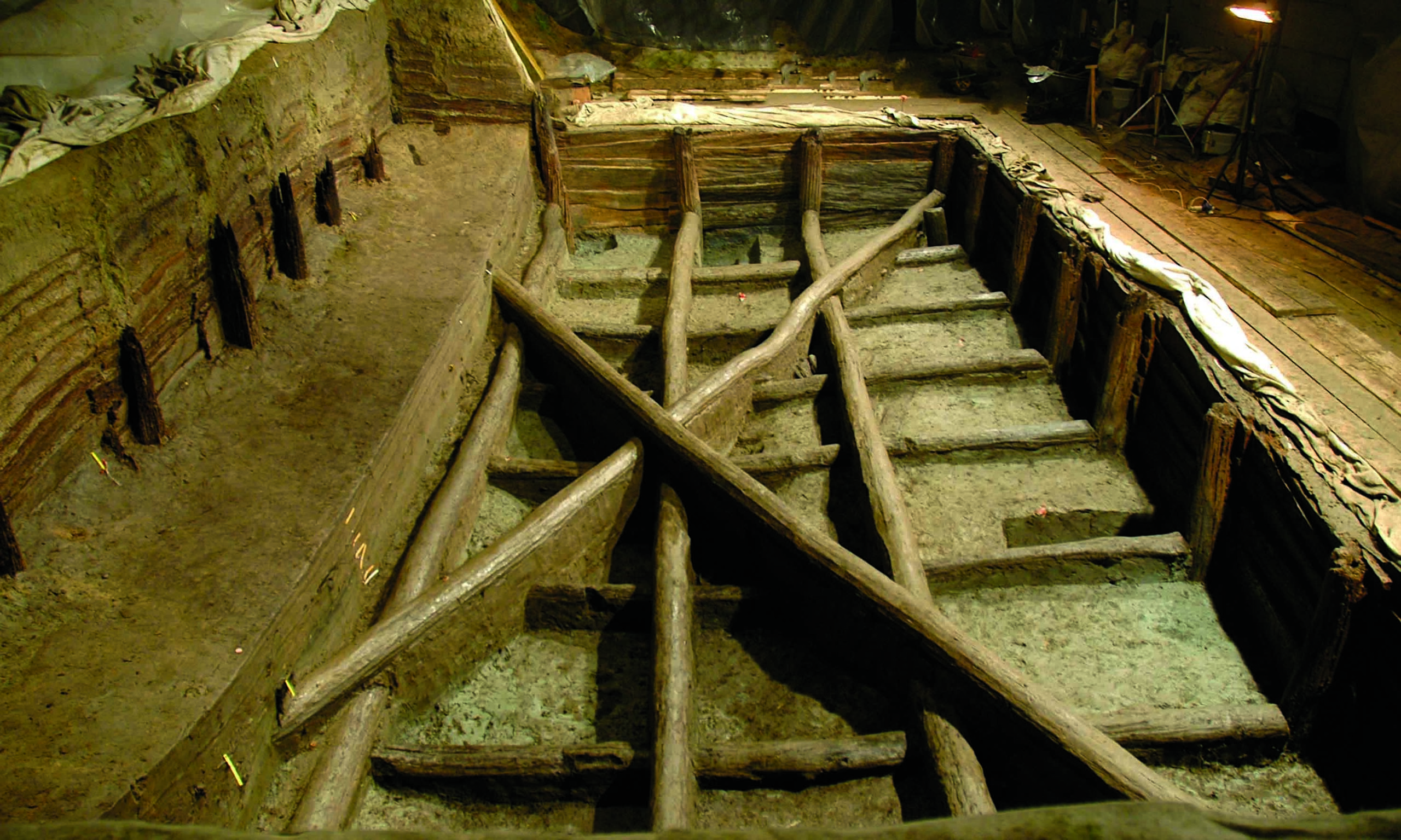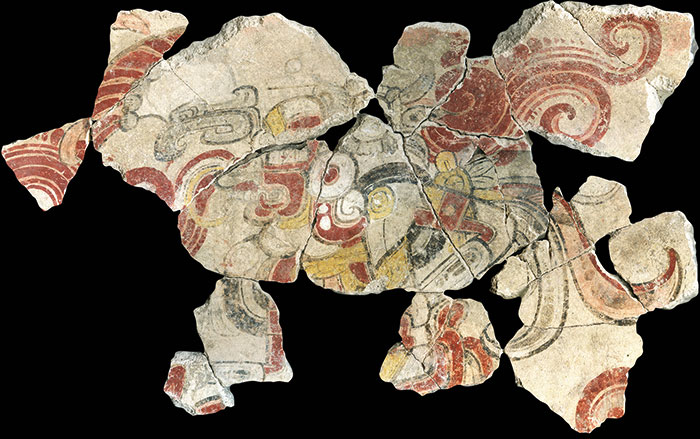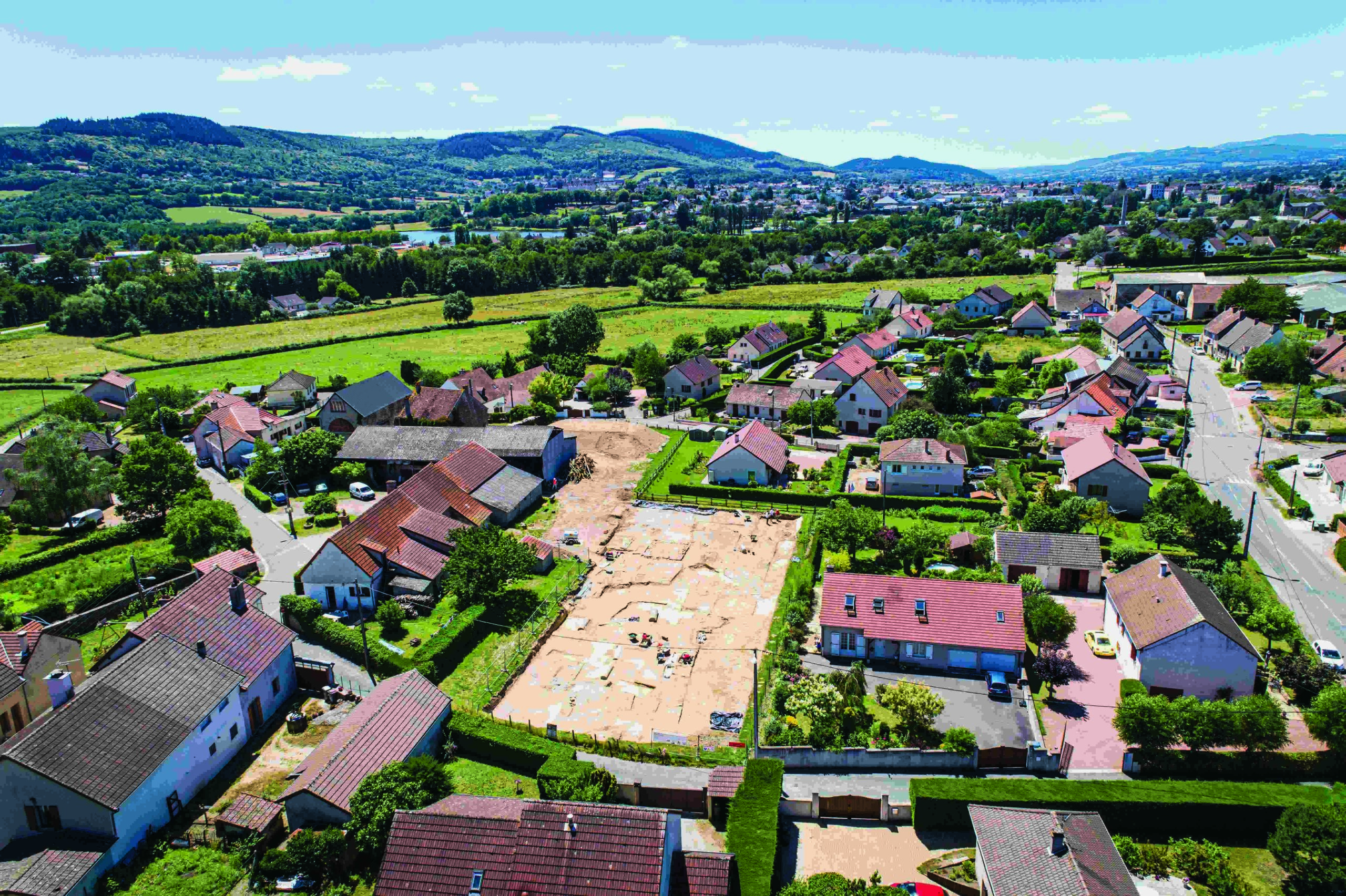
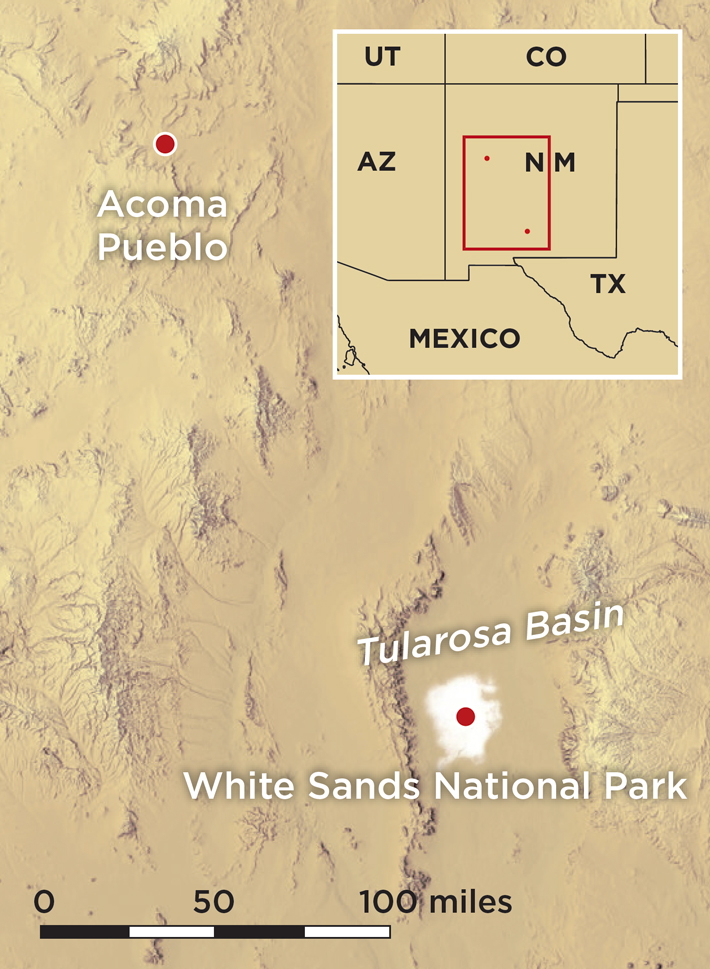
The sun shines nearly 300 days a year over southern New Mexico’s Tularosa Basin, where bright white sand ripples across the desert. Here, in White Sands National Park, the world’s largest gypsum dunes abut the dried-up bed of prehistoric Lake Otero, which once covered 1,600 square miles. In the summer, park temperatures can soar to 110°F, and the intense sunlight stings the eyes. It was one of those hot but slightly hazy days in May 2021 when Bonnie Leno and Kim Charlie, sisters from Acoma Pueblo, about 175 miles north, found the fossilized tracks of a giant ground sloth and two humans, all of whom lived at least 10,000 years ago, at the close of the Pleistocene Epoch.
Leno and Charlie didn’t expect to uncover evidence of ancient history at the park, but there they were, the kidney-shaped footprints of a 10-foot-tall, 2,000-pound long-extinct mammal and the imprints of human toes—the marks of two species that coexisted thousands of years ago. “I was down on the ground, brushing everything off,” says Leno, recalling the adult human footprint she found not far below the surface. “I was ecstatic.” Just inches away, she spotted the giant sloth track. “There were a lot of prints in that area,” says Charlie, who uncovered the tiny footprint of a child nearby.
Charlie is a member of the Acoma Tribal Historic Preservation Office (THPO) board and participates in a consultation program with the National Park Service. Any time park employees conduct studies that might affect a Native cultural site, pueblos and tribes affiliated with that site are asked to consult on the research and preservation. Acoma is one of six Native groups currently studying and protecting the park’s prehistoric trackways, says David Bustos, White Sands’ resource program manager. He invited Charlie to accompany scientists and park staff on one of the first field trips to the park since the pandemic began in 2020. She in turn asked Leno, an Acoma cultural monitor who works with the THPO to study and assess archaeological sites in culturally sensitive areas. It’s a role that the sisters say is akin to retracing their ancestral footsteps.
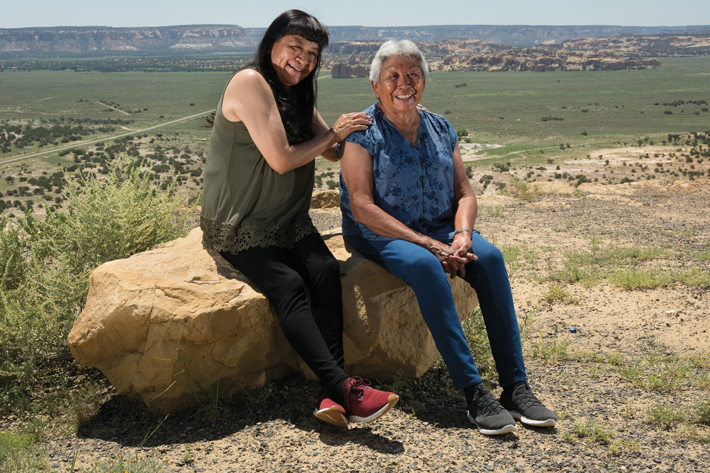
White Sands has the world’s largest collection of fossilized Ice Age footprints, numbering in the hundreds of thousands. For several years, a team of archaeologists, geographers, geologists, environmental scientists, and tribal members has worked to find and analyze as many prints as possible. No one knows who the early human trackmakers were or whether they were genetically related to Native groups in the region today, but recent findings suggest people walked through these lands far earlier than scientists commonly thought. In 2019, researchers found human tracks amid sediment layers containing seeds from an aquatic plant that grew around the ancient lake. The discovery presented a rare opportunity—the scientists could radiocarbon date the seeds to derive an approximate age of the footprints. The results confirmed the presence of humans there between 23,000 and 21,000 years ago, at a time when much of modern-day North America was under ice. That discovery revived longstanding questions about how and when people first inhabited the continent. If the dates are correct, they would disprove a commonly held theory that humans arrived thousands of years later, toward the end of the Ice Age.
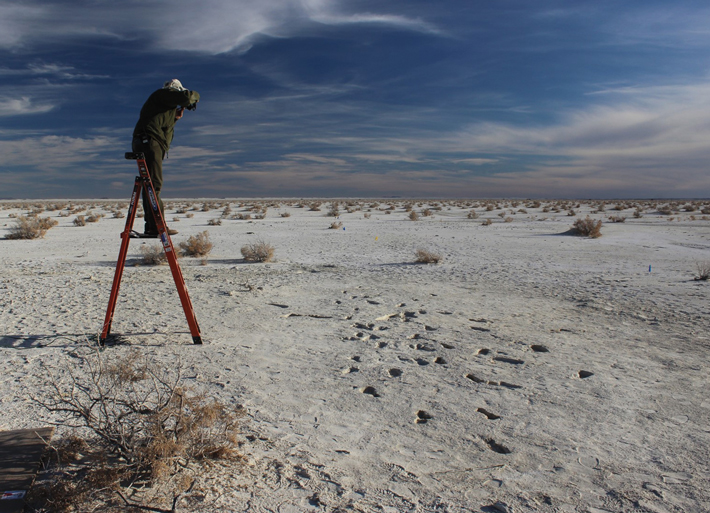
For Leno and Charlie, the new dates simply confirm the histories Native people have long understood. “We’ve always stressed that we’ve been here,” Charlie says. “We’ve always stressed that we’re the Indigenous people that lived here on this continent.” She and Leno don’t know whether their family has a direct ancestral line to the White Sands walkers, but there’s no denying the sisters’ sense of connection to the trackways and the people who made them. “Even though it’s been thousands of years,” Charlie says, the tracks “are still a part of us.”
Her people have centuries-old roots in this Southwest landscape. Acoma Pueblo is one of the oldest continually occupied communities on the continent, founded atop a sandstone bluff around A.D. 1150. Charlie says she grew up learning stories about an even older migration that took her Acoma ancestors from the far north of what is now the United States south into Mexico. “We did a lot of traveling,” she says, pointing out that her ancestors traded with people across the region, and possibly around White Sands. The two sisters hope the emerging evidence from the trackways will help bolster Native voices in the stories that other people tell about Indigenous history across these lands.
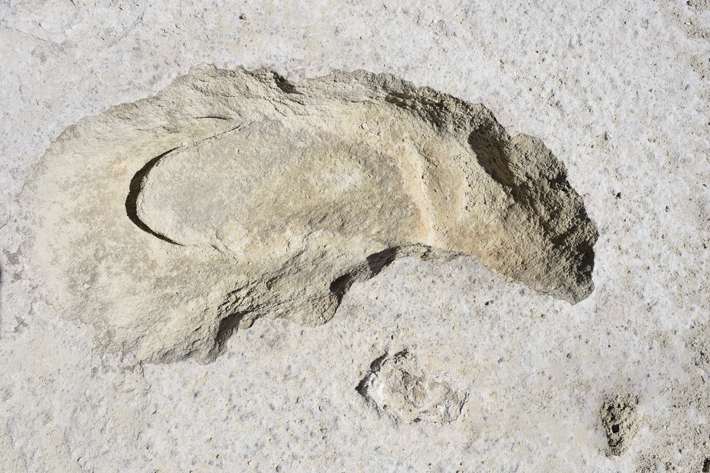
Today, the White Sands landscape, with its crests of glimmering dunes, forms a panorama of snow-white land in a summer broil. There are no trees, save for a few solitary invasive species that suck whatever moisture they can from the land. Miles of undulating sands give way to the crisp, flat surface of the dried-up ancient Lake Otero, which is dotted with iodine bush, a desert shrub adapted to sandy, salty, alkaline soils. To the east and west of the park, a heat haze distorts the peaks of towering mountains; to the north is White Sands Missile Range, the U.S. Army’s largest land-based open-air testing site. But the ancient trackways follow no modern borders—footprints crisscross both sides of the fence dividing the national park from the missile range.
At the time when many of the tracks were made, researchers think Lake Otero had already begun to evaporate and a series of small seasonal bodies of water covered the area. As the water evaporated over time, it formed a playa—the flat bottom of a desert basin that occasionally fills with water. About 15 years ago, a rare flood filled that playa with so much water that waves beat against the ancient shoreline and eroded its sediments, exposing trackways never before seen. Not long after that, Bustos began finding prints left by mammoths on the shoreline as well as elongated prints he thought might be human. As time passed, he and other researchers found more and more trackways from what appeared to be an array of species, including humans, mammoths, bison, camels, dire wolves, and saber-toothed cats. Some of the marks show evidence of people and animals slipping and sliding across what was then a muddy surface. “Many of the footprints actually have layers of algae, which would have required moisture to grow,” says Cornell University archaeologist and team member Tommy Urban.
So many footprints emerged that park staff sought guidance from Bournemouth University fossil footprint expert Matthew Bennett, who visited White Sands in 2017 and confirmed the presence of human and animal tracks. He has since made 10 trips to the park, and has no doubt that White Sands is one of the world’s most significant track sites, with tens of thousands of trackways. By comparison, Laetoli, the Tanzanian site with the world’s oldest-known hominin footprints, extends about 88 feet and contains fewer than 100 tracks.
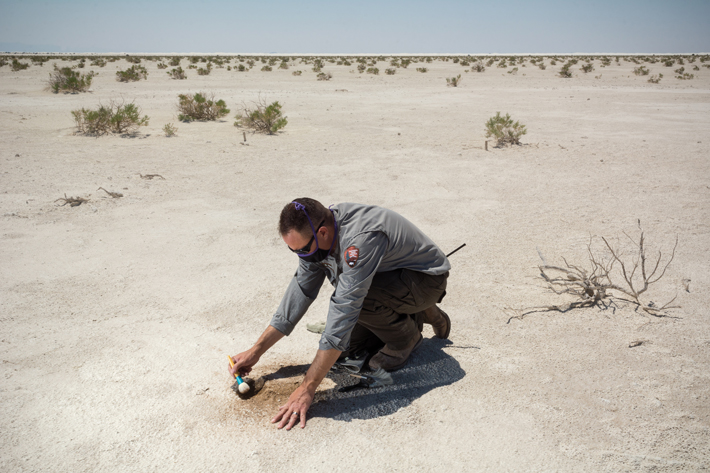
The geological makeup of the area has preserved a wide variety of prints that allow scientists to discern an array of mammalian behaviors. “This gives us a rare window into a world that’s mostly lost to time and beyond our current reach,” Urban says. The length and breadth of the trackways at White Sands open a range of questions about early hunting practices, the lives of Ice Age species, and what the world was like when humans and Pleistocene megafauna shared this landscape. “Each of these trackways will have its own story to tell,” says Urban.
For example, the team found a human pathway that goes out and back, extending nearly a mile. Based on footprint size, scientists believe it was made by a woman or adolescent male, accompanied by a toddler on the outward journey. Between the outbound and return legs of the trip, a giant ground sloth and a mammoth crossed the pathway. The mammoth walked in a straight line, leaving no evidence of having noticed, or cared, that humans were in the vicinity. But the sloth behaved differently. Variations in the animal’s footprints appear to show that it stood on its hind legs and spun around, possibly catching a whiff of danger before dropping to all fours and rambling off in a different direction.
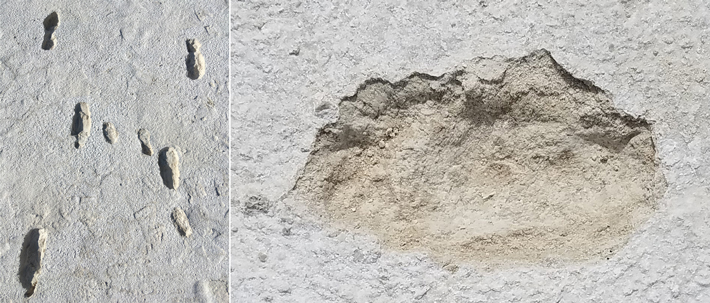
The researchers concluded that the chaperone on the excursion at times carried the toddler, shifting the child from hip to hip. This subtle change in behavior is reflected in the alternating shape of the footprints, which broaden with added weight to form a banana shape created by the outward rotation of the older person’s foot. They can also tell this was a speedy trip, completed at a pace of 5.5 feet per second through slick mud—far faster than that of a person walking at a comfortable pace of four feet per second over dry, flat land. They determined this by creating a mosaic of aerial images of a large section of the trackway that encompassed hundreds of prints. This allowed them to calculate the people’s average stride lengths. The researchers don’t know the purpose of the trek, or why it was made so quickly, except to note that the dangerous beasts of the Ice Age world would have given people plenty of reasons to hurry, especially with a child in tow.
Another trackway reveals possible evidence of an ancient hunting party. There human footprints appear directly inside the tracks of a giant ground sloth. Every indication suggests one person followed quickly behind the animal. The person matched the sloth’s stride—which was much longer than a comfortable human stride—for more than 10 paces until the sloth, it seems, rose on its hind limbs and flailed in defense. Meanwhile, a second person approached the animal on tiptoe from the side. The tracks are the best direct evidence of late Pleistocene interactions between humans and megafauna found anywhere in the world, and it seems likely they were made by two hunters confronting their prey—though whether they or the sloth prevailed isn’t clear. The notion of hunting in the region fits with more recent Native oral histories, too. “Our tribal partners have stories about the ‘white sands’ and coming down for hunting parties,” says White Sands archaeologist Clare Connelly.

With the exception of the trackways discovered in 2019, researchers have not yet been able to precisely date the footprints at White Sands. The team isn’t certain what cultures the trackmakers belonged to or when exactly they lived. “We’re dating them on the basis of the coexistence with the animals, which have known extinction dates,” says Urban. The team estimates that many of the tracks were made between 15,500 and 10,000 years ago, during a period that overlaps with the widespread North American Clovis culture, as well as the later Folsom tradition. Both peoples were hunter-gatherers who lived in small groups and are known today for their distinctive tools. Characteristic flaked Clovis spearpoints have been found with the bones of megafauna such as mammoth, and smaller worked Folsom points are often associated with bison kill sites. The White Sands tracks indicate the people—whoever they were—followed, stalked, harassed, and possibly hunted big game.
The footprints tell other tales, too. Bennett says that he and the team have uncovered evidence of many children jumping, skipping, and sloshing in the mud, their horseplay preserved in time. As a father himself, these findings spark his imagination. “Every kid loves to jump in a puddle. And basically, prehistoric children were no different,” he says.
Each day in the field is different for the research team, partly because weather conditions have to be just right in order to discern the tracks—too wet or too dry, and little is visible. For this reason, the White Sands prints are often called ghost tracks. “They can be very clear on the surface one day, and then another day, you can barely see anything,” Bennett says. “They’re quite mercurial.” That makes the work of identifying the trackways even more challenging. “It’s hard to orient yourself,” says Connelly, “because the site is never the same.”
Not only are the tracks difficult to identify, but one by one, the White Sands archive of Pleistocene life is steadily disappearing. Wind erodes the fine surface that covers the footprints and, once exposed, they quickly vanish. “We’re not sure if it’s climate change, or what’s happening,” Bustos says. “We’re losing them.”
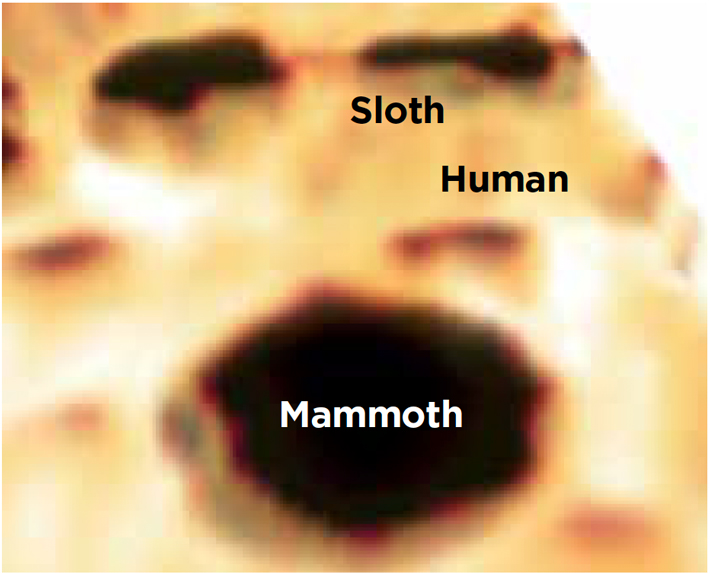
The team is documenting trackways as rapidly as they can, using an array of tools to locate new prints and quickly gather information from those already identified. While erosion constantly exposes new trackways, the team also searches for those that are less visible. Urban has spent most of his time in the park conducting geophysical surveys using magnetometry and ground-penetrating radar, which allow researchers to create images of tracks that lie below the surface. The team then uses traditional tools to carefully remove sediments and expose the prints and record them. They make plaster casts and 3-D models of some of the tracks, though there are far too many to record them all in this way.
All around the playa, in every direction, the paths of creatures from the past preserve very specific moments. Humans ran on the balls of their feet. Families of all species—people, mammoths, camels—traveled together. There is also other evidence of ancient life lying on the surface. When Leno and Charlie visited, they immediately spotted what they thought was a grinding stone resembling those still used to smash corn or make jerky at Acoma today. “I’ve walked by here like forty times and I haven’t seen that,” says Bustos. “We’ve had geologists look at these rocks and tell us, ‘Oh no, they’re here naturally,’” adds Connelly. No one else had identified what Leno and Charlie saw.

The two sisters say that when they visit a cultural site, they think of how their people live today, how their grandparents lived, and how the Ice Age trackmakers might have done things, too. “What were the women doing?” Charlie always asks. When they look across White Sands, they think it must have been a hunting ground with nearby campsites where the community gathered. “You see the footprints, you see children’s footprints,” Charlie says. “So you’ve got to think…” Leno finishes her sister’s thought: “…that was family.”
The team is further scouring the area, searching for the remains of hearths or other clues to how people lived, camped, and hunted in the area. They’ve also found perplexing grooves in the ground that might be related to the human tracks. “We’re not sure exactly what’s going on,” Connelly says, but the team suspects the people dragged something on a large stick. “We only see these where we see human footprints, so we just call them drag structures,” she adds.
After examining the grooves, Charlie and Leno think these abrasions could be additional evidence of hunting. “You take down the mammoth, there’s no way you’re going to carry that big carcass on your back and take it home,” Charlie says. Perhaps, the sisters say, the marks were left by sleighs that hunters used to haul the meat of especially large prey.
The two also spotted a group of rocks situated in a near-circle that reminded them of sundials common in the Southwest. Across the region, Native populations have long looked to the sun, the moon, and stars to keep track of time. Leno wonders if, at some point, the rocks signified that people did something similar at White Sands.
For Charlie and Leno, it’s not enough to simply study the trackways and other artifacts; it’s also important to honor the ancient people who left them. When the Acoma people visit a cultural site, they always ask permission from the spirits of those who passed, akin to asking permission to enter somebody’s home, explains Leno. “If they want to let you know something, find something, they will,” she says. “They will show you,” adds Charlie.
The sisters count themselves lucky to have seen these footprints, which appear and disappear so quickly. Most people will never have that opportunity. The National Park Service is creating replicas of the trackways for visitors to view and touch, but the experience isn’t the same as being under that blazing sun, in the exact locations where so many thousands of people and animals made their marks ages ago. “I wish we could keep those tracks intact for everybody to see,” Charlie says, but she accepts that she has no control over their survival. “That’s really up to Mother Nature.”


